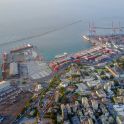
Small Modular Reactors – Physical protection and computer security must be thought through at the right time
Small Modular Reactors (SMR) play an essential role in new developments in nuclear technology. This term covers a large number of different reactor concepts that are generally designed for an electrical output of 300 MW or less. Smaller light-water reactors have been around since the 1970s; however, for the development of SMRs, existing reactor concepts are being further developed and new ones are being devised (a more detailed description of SMRs and of various concepts can be found here). The developers hope that the small-scale reactors will have both economic and safety advantages - for example, through the use of alternative coolants and passive safety systems.
SMR concepts at very different stages of development
SMR concepts currently under discussion among experts are at very different stages of development. While most of them only exist as concept studies on paper, SMR concepts have already been certified by individual supervisory authorities with regard to their safety design, or contracts for the construction of such plants have been signed - for example in the USA, Britain, Romania or Poland. In some cases, SMRs are already under construction or in operation, for example at the Russian Akademik Lomonossow.
While safety aspects play an essential role in the development and also in the licensing processes of SMR concepts, questions regarding the necessary protection against malicious acts are often still not taken into account.
This is mainly due to the fact that measures against malicious acts initially have no influence on the basic functioning. However, just as with conventional nuclear power plants, aspects of physical protection and computer security must also be considered in good time for SMRs and taken into account in the concept.
What are the requirements and aspects for the physical protection and computer security of SMRs?
In a research project funded by the Federal Ministry for the Environment, Nature Conservation, Nuclear Safety and Consumer Protection, GRS researchers are looking into such questions. Specifically, they are analysing existing requirements and identifying those aspects that play a role in the physical protection and computer security of SMRs. Such requirements and aspects have not yet been systematically pursued and evaluated at GRS. Therefore, the first task is to compile and process them and then to apply requirements and concepts regarding protection against malicious acts from already operating nuclear facilities to SMRs, as far as this is possible.
For a systematic description and evaluation of the various SMR concepts, their characteristic properties will be determined at the beginning of the project; these may be, for example, the location and type of use of the SMR, the physical protection levels around the nuclear fuel or the type and scope of the instrumentation and control technology used. On the basis of these characteristics, a comparison will then be made with security requirements from the point of view of physical protection and computer security.
Identifying strengths and weaknesses of the new reactor technology
In a further step, it will be assessed whether standardised/proven physical protection measures can be applied or whether there are challenges or open questions regarding the physical protection and computer security of SMRs. For the latter, the researchers want to develop approaches for alternative security measures.
"Overall, GRS wants to deepen its technical knowledge in the field of physical protection as well as computer security of SMRs and further expand GRS's expertise in this area," says Dr Jan Peter Schupsky, who is providing technical support for the project. "Nuclear safety is a cross-border task - that is why it is important to be up to date and to know the strengths, but also the weaknesses of new reactor technologies. Unfortunately, physical protection and computer security are often considered secondary to safety. We want to change that with this project.“
Project highlights Physical Protection

On 4 August 2020, a devastating explosion occurred in the port of Beirut, the cause of which was the improper storage of chemicals. After Germany had already supported Lebanon in the management of chemicals in the aftermath of this explosion, the Lebanese authorities approached Germany with an additional request for support in the retrieval and safe storage of radioactive waste. Within the framework of a cooperation project funded by the Federal Ministry for the Environment (BMUV), the responsible Lebanese authorities are supported by experts from the BMUV and an interdisciplinary GRS team from the departments Radiation Protection and Security.